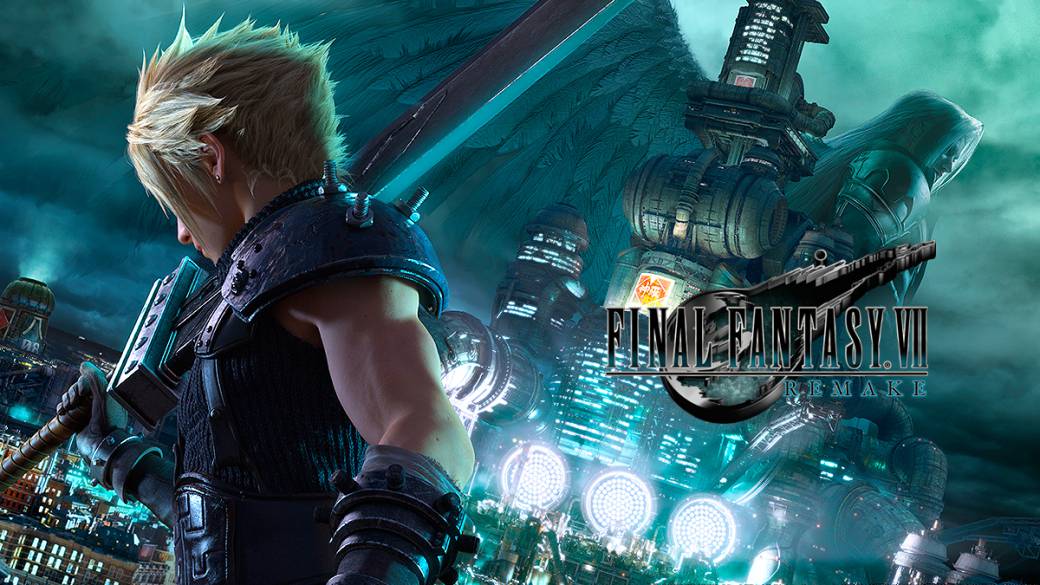
Square Enix launches, after five years since its announcement, the long-awaited remake of one of the best games in history.
Within a few seconds of starting Final Fantasy 7 Remake, a close-up moves from Aeris' hands as he drifts away in the distance and high. This allows you to see how the camera leaves behind a giant Midgar. The industrial city where the title happens and where the original 1997 game began. The camera keeps going up and Midgar keeps getting smaller and smaller, despite being huge. Then, the camera zooms in again, penetrating between the pipes of the sectors, reaching the train from which Cloud is going to jump to start his mission as a mercenary. The Remake of one of the best games in history begins.
This first scene is quite a statement of intent. It focuses on Aeris, more of a protagonist than ever, and above all on how vast the title's area of action is, or pretends to be. Final Fantasy 7 Remake happens during the events of Midgar, which would be about 6-7 hours of the original game – less when we have replayed it – and what they mean about 30 here without counting side missions and extras. The game wants to alert us from a moment that Midgar is giant, that it has many unknown places and that this scenario can host a complete game from start to finish.
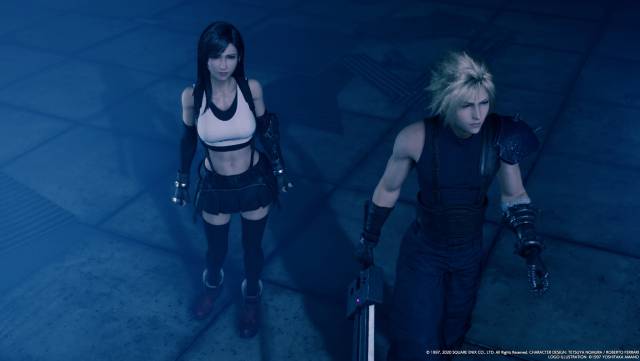
And so it does. Navigating between the tribute, the nostalgia and the updating of the JRPG with the greatest impact in the industry, the one that was a sign of the new times in the mid-nineties and that made its way in the West like few others – and not for lack of quality – they had done before. But Final Fantasy VII Remake goes beyond what we could consider a remake. It is a game that expands, that puts the focus on everything that was circumstantial in 1997 and, also, allows itself the luxury of rewriting what the fans know by heart.
The course of the game throughout its 75% plot maintains the basic pillars of Final Fantasy 7. There are variations, a lot of new content but the great events are happening: from Cloud's first commission with the avalanche ecoterrorist group, through the assault on Reactor 5, the encounter and journey with Aeris, the Tower of sector 7 or the assault on Shinra. But even during this journey we see that something is changing. In great situations and key moments, some species of ghostly entities – called echoes – follow and guide us. Sometimes we fight them, others are a containment dam for enemies. Their presence reaffirms situations that we know, they allow events to happen as we knew them.
We will not enter gutting, but it is in the final stretch where everything ends, the reason for the echoes is revealed and where the eyes are fixed on Tetsuya Nomura, known for the Kingdom Hearts saga and for spinning and twisting arguments, to times more than the count. The last part of the game rewrites what we knew. Past, present and hopelessly future. It opens a new path for the next chapters in which it is not clear what we are going to find. And that can baffle the fan looking for a Remake of what is surely their all-time favorite game and end up finding clues to something more akin to a reconstruction. It's hard to gauge how this will sit in old and new players. In our case, the evolution of events has seemed somewhat disappointing for what it may mean, but on the other hand, it can also be interpreted as a way to keep the canon and the original work intact and go for other directions.
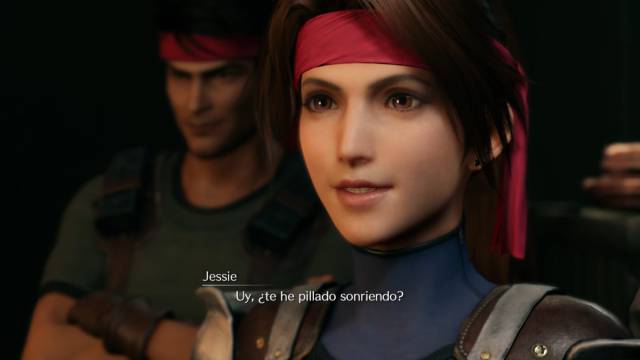
He will not leave anyone indifferent. Perhaps those who do not know the original plot and do not quite understand some of the things shown. Because that's another one, the audience the game is aimed at. The title drops flashbacks throughout the game that are identifiable to the veteran player – like some moments from the village of Kalm – but are simply indecipherable to new users.
Old and New Midgar
Final Fantasy VII Remake is a game that goes into detail and that leaves no time loose in which to satisfy the fan. During the first half of the game, it wants to be what everyone wanted when it was announced at E3 2015. On the one hand, a spectacular and contemporary recreation of major PSX game events. This is seen in characters, models, dialogues and spectacular scenes to finish off great enemies. In fireworks everywhere that catch the player. It is almost impossible not to say that this is "impressive" during its first bars, because it captures in the middle of 2020 what we played in 1997, with what it implies at the technological level and at the level of nostalgia. There are many moments where emotion is wasted, but we will not detail them.
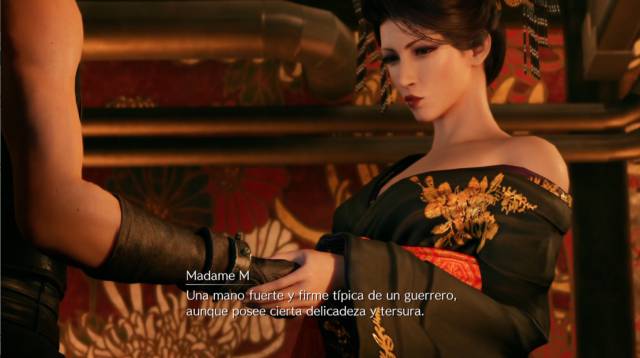
In addition, it does things very well when it comes to expanding that unknown Midgar that they said they wanted to discover us. The first, the treatment of the characters. In the first chapters we delve into relationships that barely develop in the original game. One of them is Jessie, a member of Avalanche with whom Cloud makes an interesting contact. The creation and depth of the character is very worth knowing, because it becomes a reason why, reluctantly, the mercenary hired by this group who only wants his money to perform tasks, ends up linked to them. The rebuilding of her and her other two companions, Biggs and Wedge, is notorious and convincing.
As it is, too, the relationship with Tifa. One of the chapters is dedicated to Cloud and this supposed old friend of hers doing work for their Sector and catching up, giving the player much more context – although still incomplete – of their true relationship. Much more than in the Midgar hours of the original. And so the first chapters advance: narrating the great known events interspersed with an expansion in the form of tasks and relationships that help build a team and make more sense for Cloud to join the cause of Avalanche.
Separate mention deserve other key names such as Aeris and Sefirot. The first, which we came across in the second chapter and which we will meet later, after the events of Reactor 5, gives off a personality and nuances that make it even more interesting and intriguing. Also because here, he seems to know or intuit more than what his bodily innocence transmits. More than he seemed to know in 1997. Sefirot, on the other hand, goes for other courses.
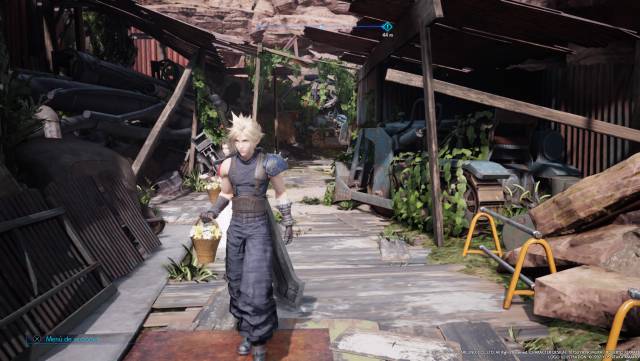
The great enemy of Final Fantasy 7 was a legend SOLDIER, the military group to which Cloud belonged and which he deserted, of which all speak almost like a myth and of which we hardly know things until the end of the Midgar part. Not here. Here he appears soon, and he appears at different times before Cloud, who shows his irrational hatred towards him. His presence, his staging of a great unscrupulous villain, distances him from the initial conception that we have of Sefirot to give it a magnitude that serves for the plot reconstruction of the final stretch. It imposes, but along the way we have lost that way of knowing man before the legend, and the legend before the monster he becomes.
The new Midgar also leaves us locations to remember at many times. The recreation of some of the sectors is just as we could imagine at the time, and places like the Mercado del Muro shine with their own light. A world overflowing with excesses perfectly recreated with the characters they inhabit, with the missions we must carry out, with mini-games (squats, dancing …) and keeping the original: Don Corneo is a pig and Cloud is very cute dressed as a girl.
On a visual level, Final Fantasy VII Remake constantly shines thanks to the character modeling, the video scenes and well-worked animations. The design of the key characters plays another league, although among the new ones some do not seem to be from the same universe. On the Move is a spectacular game where the effects of spells, blows, summons and limits are pure fireworks. The recreation of locations that we saw over 20 years ago is noteworthy, too. Like the mentioned market or Shinra. But on the other hand, it has evident texture problems in open scenarios and many of the closed spaces end up being more monotonous than the design account.
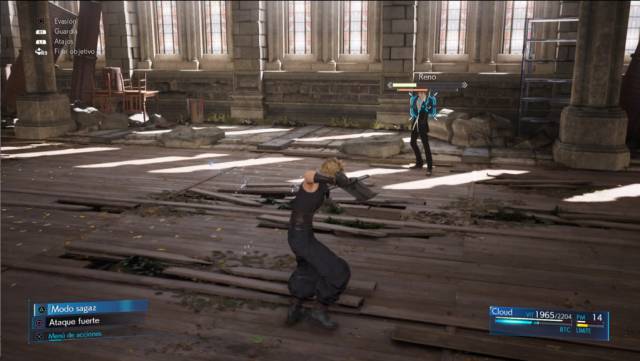
The way is combat: the ultimate ATB
The Final Fantasy VII Remake has a very marked development and a very clear structure where the great playable channeler is combat. Everything revolves around the fight as the main mechanic. We say this for two reasons: the first, because it is the total star of our advance. The second, because the rest is in the background if we stop to talk about what we can do at the controls.
Final Fantasy and other Square games have always been linked to the ATB system, Active Time Battle, a battle system in which a bar is filled in to act. In this way, the turns were given dynamism because depending on the bar reload speed, we could attack more than once before the enemy, or vice versa. Here, the active battle system jumps to the front to be fully real-time but retain the essence of the saga. Basically, with squares we can make normal attacks that reload the BTC bar to be able to carry out actions: own abilities, spells or the use of objects. Or the use of the triangle, which offers special abilities for each character. Cloud has two positions to attack stronger and to be able to make counterattacks; Tifa has a stunning stun of her own, and Aeris can charge a magical attack. Barret, launch a loaded cannon that reloads a lot of BTC bar.
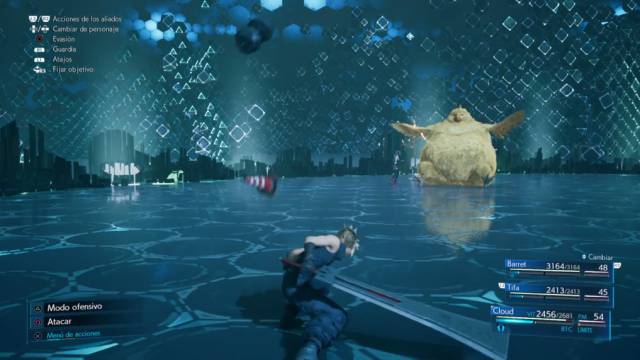
What at first may seem like a square pound ends up being, in reality, something very deep and versatile. No, you are not going to be able to pass the game by hitting the attack button. The mechanics can be used for weak enemies, but above all it is a way to make the bar faster to use the menu. The fact of being a game in real time forces us to learn the patterns, to escape, to change the character we control and to manage everything at high speed.
We use a square to load a bar, we enter the menu and select who we attack and with what ability, we use the command triggers to indicate the actions of our comrades with a loaded bar – if not, they act automatically – and then with a crosshead we move on to controlling another character to prepare new actions. Everything is very dynamic and forces us to learn from the enemy: their bosses can cut our attacks, if we do not cover ourselves we will spend too much ether and potions to heal ourselves and there are attacks that force us to dodge or run to get out of danger zones.
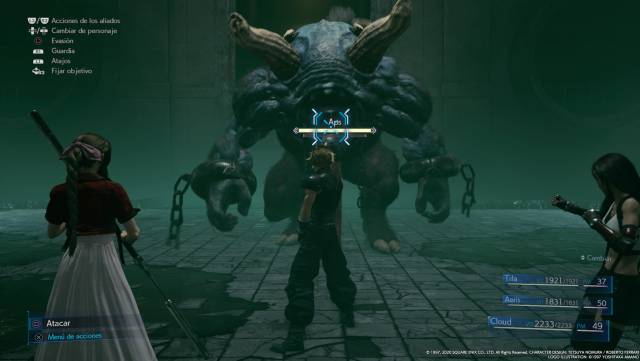
During the first bars, the combat shines with the final bosses, who have different patterns, phases and weak points to exploit. But there comes a time when strategy is necessary in every confrontation with enemies. Always looking for the same thing: fatigue them and fill the said fatigue bar until they are vulnerable to launch all our fury. Some are flying and can only be reached from a distance, others block frontal attacks and they must be surrounded or guard raised. Others are weak against certain spells. In many cases, it is necessary to monitor the altered states that they cause, and draw a route to follow to finish off the most annoying ones first.
But the big display is in the bosses. There are many, and in fact the final stretch is a rush from boss to boss, each of us needs new strategies to overcome them. The speed at which we navigate through menus healing, empowering, attacking with this spell and that ability, is noteworthy, as well as Limit attacks, available when a limit bar is loaded and that you have to know how to spend at the right time . We have had battles with bosses that simply remove the hiccups due to the epic that emerges at the audiovisual level and the constant use of various tools, enemy study and execution. The bosses of the game are the ones that go up by staging and variety: huge machines, beasts, modified monsters, one-on-one combat with a clean sword, giants that seem to be taken from other universes … There is everything, and almost they all work.
And all this with a well measured difficulty. The title is accessible at first, but it becomes demanding. If you do not understand how to overcome a great enemy, you will end up spending an enormous excess of resources or you will die a lot. And that is very good. It is not an excessively difficult game, but it demands the player. Of course, it has a problem that becomes evident at times: the camera. Sometimes it is lost, for reasons of design of the combat place or by the movements of the enemies, and although the lock on works, it can play tricks on us when we change characters or look for the specific objective.
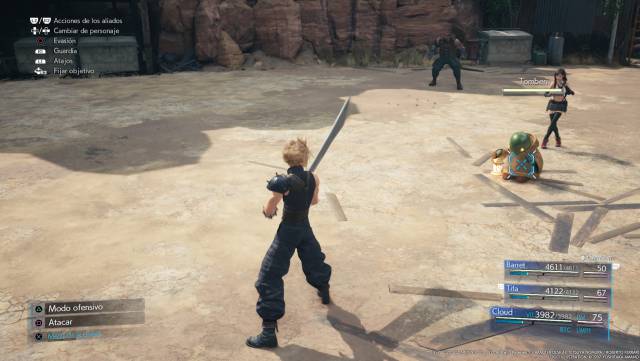
Team-building: Weapons, upgrades and materials
Spinning with the satisfying combat experience is the fact that Final Fantasy VII Remake is an RPG, not an action game, and therefore neither the square serves to end all of them nor our skill dodging and blocking will be the only thing necessary to win . As we move forward we are getting new weapons that provide improvements of all kinds to our statistics, and that have unique abilities. When we have 100% proficiency, that ability is transferred to any weapon we carry, but the best thing is that as we improve, we can profile our character type in a more offensive, defensive or balanced way, unlocking passive improvements for weapons: more life,% magic damage, physical or magic defense, etc.
As weapons improve, spaces for materials grow. The system, inherited from the original game, allows us to equip and combine materials in weapons to be able to versatilely customize all our characters. Healing and magic spell materials for Aeris, damage and life enhancements for Cloud, power-ups for Tifa or simply a mix where everyone has a cure, some pyro, others ice …
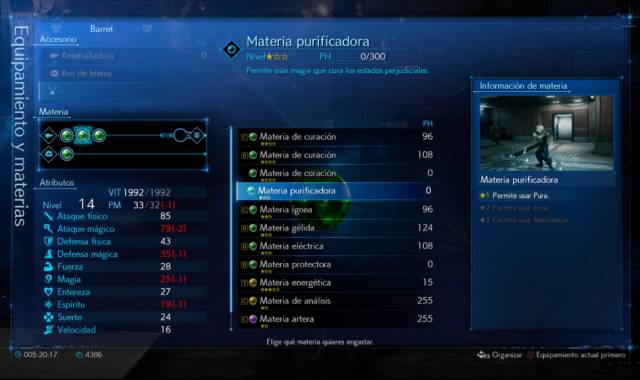
The construction of the character and the team is completely free, it can be changed at any time and it provides a lot of possibilities necessary for each moment: there will be situations where we will fight with some specific characters, and therefore it will be necessary to rebuild their team of materials. There is no use having a character of adequate level if the materials of electrical attacks are not equipped in characters that are before a boss that is only weak to this element. The materials, in addition, evolve as we use them, being able to achieve more devastating attacks and, of course, higher spending of magic points, and you can combine some of them, enhancing the effects.
The weapons, equipment and accessories, materials and weapon upgrades make an ideal mix to build the characters in the direction we want. As a rule we do not have weapons that improve others, but some power some states (the magical attack on top of the physical, for example) and others, others. It is what we build with all the elements that ends up defining the characters individually and the team in general.
Advance, Cloud: between being linear and being corset
We said that combat is the basis of everything in Final Fantasy VII Remake. It is for its options, for its epic and for its versatility, but also because the game does not offer very convincing mechanics outside of it. Remake is a very linear game, divided by chapters and with a limited margin of movement.
The controversy is in the development of the main plot. Being linear is not bad per se. Final Fantasy, especially the modern ones since the X, has always been quite linear and that has not stopped giving us games to remember. The problem that we see is that it is one thing to have a linear development and the other to be excessively corset in our actions. And that happens often. Going straight is the only option, with obvious small detours to find the chest on duty. It is almost impossible, except in one chapter, to get lost. Everything has an ABC sequence in dungeons and on crossings to reach our goal. And the additional mechanics are pure transition: the levers open the only possible way for us; the hook to reach high areas is only used when we need to go to the only point we can go to continue moving forward. Even Red XIII, which we were told would be key in a stretch at the end, ends up being that: another mechanic limited to being used at the specific moment to go to the only possible next place (in addition to fighting with us as NPC at various times , yes).
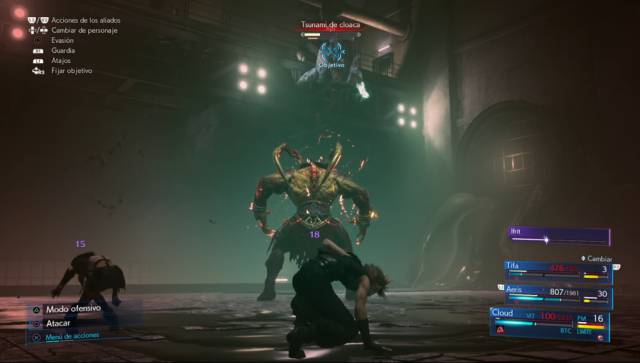
At the design level, this decision —even if you stray too many times the game tells you that that's the wrong direction— ends up weighing on several of the chapters. After episode 12 there are certain sections in which the rhythm suffers from these marked and closed structures. There are chapters that become excessively long. Chapters that weigh for their playable development, because they contribute nothing at any level. How does that save the game? in part it achieves this through combat: the ability to present us with new enemies even when we get more than 20 hours of gameplay. And that is appreciated, although development in some phases falls into tedium.
It can be said that in structure at times it is reminiscent of Final Fantasy XV, they are that guide during the plot made and thought so that what is predefined is seen and done. It is not the only thing that reminds us of the last numbered installment. Also the presence of some new characters that seem to be taken out of that universe for their style and extravagance, or in the use of invocations: it is true that they are not special effects as in the XV, but they are limited again: they can only be used in phases of specific battles. Once they appear (Ifrit, Shiva, Fat Chocobo, Leviathan …) we can order various attacks and when their time in combat ends, they will launch their last blow. But now.
On the other hand, we have a series of specific chapters in which, arrived at some specific place, we will be able to solve some secondary missions. These are far from being close to what was promised, quality and narrative as powerful as the main plot. Not even remotely. Yes, there are missions with some scenes and extra dialogue, but as a rule they are based on finding five children lost in the sector, going to a place to clean enemies, getting some objects and little else. They are not a great source of inspiration, although they do have interesting rewards in some cases.
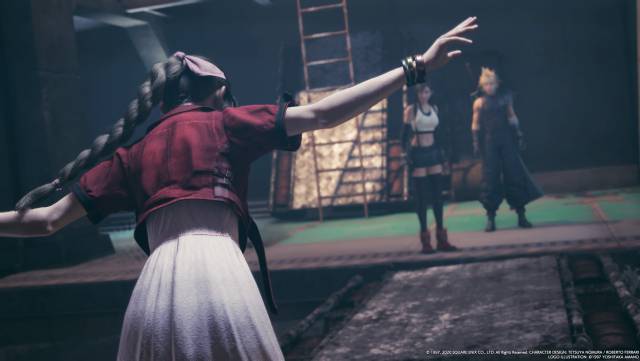
Epilogue and endgame
The final section is a great audiovisual show and it works because it is based on the best of the game: boss after boss, each one more epic and demanding. The orchestrated soundtrack plays a relevant role, a marvel. The usual melodies with all the epicity possible, which are capable of giving you goose bumps when you get to Aeris' house or when a fight against a boss starts. It is worth stopping to listen and turn up the volume to the maximum in the moments of greatest tension, because the ecosystem that is created between music and what happens on screen is unique.
And once finished? A somewhat strange endgame. When we finish the game we can select the chapter we want to play to do the tasks that we have pending, but with one condition: they will only count us as finished if we finish the entire chapter. That means if we want to do all the secondaries from Chapter 14, then we'll have to finish the main plot with its not-too-inspired sewer sequence, one of the least inspired stretches in the game. If we want to make ourselves the entire Don Corneo coliseum or Shinra's VR machine – with high-difficulty challenges, secret bosses and what would be the real post-game – the same. We also unlock hard mode, where enemies are stronger, have new patterns, and can't use items.
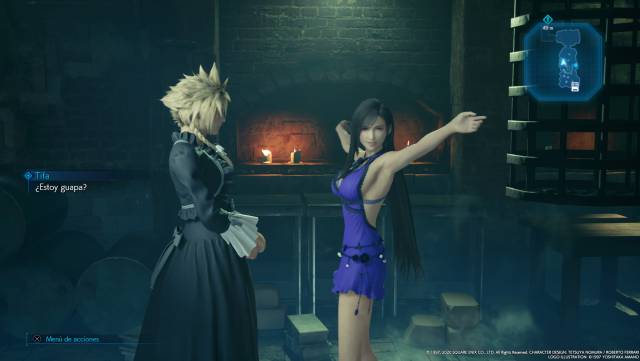
CONCLUSION
Final Fantasy VII Remake is largely what we had wanted for many years, but it is also a game that aims to go far beyond the concept of remake. The journey through your main adventure goes through different phases. We started excited, thinking that this is what we always wanted. A plot that shows us in 2020, with what this implies, what we experienced more than two decades ago. And who also knows how to gladly expand relationships, moments and characters that went unnoticed in the original. We continue to be enthusiastic, for this recreation of characters visually, for a soundtrack from another planet and for the spectacular nature of everything in front of us.
Then we move on to a temperance phase, more calm Reviews of strengths and weaknesses that are consolidated throughout the game, since as it progresses it shows its two sides of the coin: a very convincing combat system and character progression , varied and versatile. Full of great bosses and demanding in difficulty, without being a walk or an impossible challenge. On the other side of the coin, yes, a linear development, which is not bad in itself, but excessively narrow, that this is more debatable, with evident ups and downs in level and rhythm design, some unnecessarily elongated and with somewhat mechanical clumsy that don't add up, especially in the second half. And finally, we end up bewildered with an outcome of events at the plot level that is disruptive, unexpected, although it is intuited, and because it leaves many unknowns facing what is to come. For the fan of the original and for the new one.
THE BEST
- The combat system: dynamic, tactical and packed with tools
- Versatile system of materials and weapons to customize characters and equipment according to each moment
- Large number and variety of enemies, especially bosses with bosses, phases …
- At the audiovisual level, it is very spectacular for scenes, combats and a soundtrack that looks like never before.
- How relationships and characters that went unnoticed in the original expand
- Packed with epic moments, with a breathless final stretch
WORST
- Some technical problems in textures
- Ups and downs in rhythm and development of certain chapters, excessively closed and unnecessarily long
- Side missions uninteresting
Very good
Game with a remarkable finish that we will enjoy and remember. A good purchase, highly recommended for lovers of the genre. It is well cared for at all levels.
